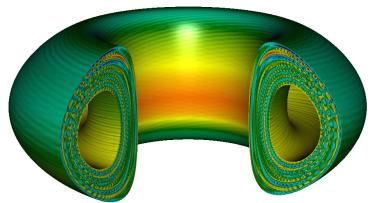Plasma Theory and Simulation
Overview
In recent years, there has been a paradigm shift in plasma physics research. In the past, large magnetic fusion experiments have made considerable progress, with theory often being subordinate and loosely coupled. This is rapidly changing, becoming an equal three-way partnership between theory, simulation and experiment. Computing is now playing an equal role in this triad.

Electrostatic potential of a toroidal plasma calculated by the GEM gyrokinetic turbulence code.
The CU plasma simulation group uses large-scale computing to better understand nonlinear plasma physics. The group's core value is the importance of the synergy between good theory and good computing. The group's research is primarily in magnetic fusion tokamak turbulence and transport, but includes research in magnetospheric and auroral space physics. We are generally interested in studying low frequency magnetized plasmas using gyrokinetic and gyrofluid equations, along with fluid-kinetic hybrid models. These are three dimensional simulations using realistic geometry. We are also active in developing nonlinear delta-f methods, nonlinear fluid closure schemes and renormalized kinetic equations.We are generally interested in studying low frequency magnetized plasmas using gyrokinetic and gyrofluid equations, along with fluid-kinetic hybrid models. These are three dimensional simulations using realistic geometry. We are also active in developing nonlinear delta-f methods, nonlinear fluid closure schemes and renormalized kinetic equations.
The group is very active in using large massively parallel computers with interest in domain decomposition and other algorithms for particle-in-cell simulation. We have experience with message-passing and data parallel programming. We are currently using some the world's fastest unclassified supercomputers including the NERSC Cray XT4 and ORNL Cray XT5. Scientific visualization is crucial in understanding the data coming from these large-scale three-dimensional simulations.

